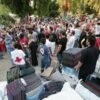For autonomous cars to be able to navigate, their optic sensors—like cameras and laser—require a clear view. Now, researchers at Örebro University have successfully improved the precision in radar sensors for navigation to such a degree that the sensors can be used in autonomous cars, making them for safe driving whatever the weather.
“The advantage with radar is that it works in all weather conditions and can ‘see’ through smoke and dust,” says Daniel Adolfsson, doctoral student in computer science at Örebro University.
With this new method, an autonomous car that has traveled 100 meters, is able to determine where it has traveled with a precision of 1 meter. That is an improvement of the radar sensors’ positioning system by 1 meter.
“Reducing the error margin from 2% to 1% is a huge step forward. The method is both very quick and precise, which is just the ticket if autonomous robots are to interact safely with humans and other robots,” says Daniel Adolfsson.
Today, autonomous vehicles most often navigate using laser sensors. With this new method, radar positioning is closing in on the type of precision that can be achieved with laser. This means that radar sensors can replace laser sensors on vehicles that need to operate in conditions with poor visibility, since radar sensors have the ability to penetrate smoke, dust and fog.
“Our work with improving the precision of radar sensors can lead to autonomous cars being able to drive safely no matter the weather conditions. It can also prove useful within the construction and mining industries where autonomous heavy-duty machinery must be able to operate in environments with a lot of dust.”
Creating maps, an essential piece of the puzzle
Using radar sensors, it is now also possible for autonomous robots to create their own maps—an essential piece of the puzzle to create reliable robots that are perceptive of their surroundings. These maps also play an important role for robots’ ability to communicate with one another.
“The goal is to create maps that these robots can understand and position themselves in, only by using radar sensors,” says Daniel Adolfsson.
As part of his doctoral project, he is also studying how to prevent errors from happening when robots map out their surroundings.
“Ultimately, there will be some errors. The important thing is that we create robust systems that can detect and correct them when they do happen.”
Knowledge of what impacts navigation
The researchers’ new method has been published in the journal IEEE Transactions on Robotics. They have also presented which parts of the algorithm actually affect navigation precision.
“We have studied every part of our algorithm to understand exactly how big of an impact the different parts have on position precision. This knowledge may be of help to other scientists as they create similar algorithms.”
More information:
Daniel Adolfsson et al, Lidar-Level Localization With Radar? The CFEAR Approach to Accurate, Fast, and Robust Large-Scale Radar Odometry in Diverse Environments, IEEE Transactions on Robotics (2022). DOI: 10.1109/TRO.2022.3221302
Provided by
Örebro Universitet
Citation:
Radar navigation for autonomous cars can ‘see’ through smoke, dust and fog (2023, February 27)



